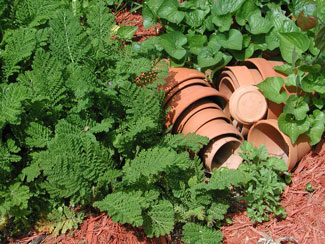Resource Library
Plant of the Week: Tansy
The University of Arkansas System Division of Agriculture does not promote, support or recommend plants featured in "Plant of the Week." Please consult your local Extension office for plants suitable for your region.
Plant of the Week
Tansy
Latin: Tanacetum vulgare

Common tansy has a long history of cultivation in Western culture but in modern terms it has been relegated to the status of escaped weed.
When John Winthrop Jr. walked ashore at Plymouth Rock in 1631 to help found the Plymouth Colony he had amongst his possessions tansy seeds (Tanacetum vulgare). Today tansy is, though still occasionally seen in gardens, considered a weed that has naturalized in scattered locations throughout much of the United States. While it may be a weed today, to its New England settlers it was an important part of the traveling pharmacopeia that went with people when they traveled to new lands.
Tansy is a vigorous rhizomatous perennial of the daisy family. It typically grows about 3 to 4 feet tall and wide with erect, unbranched stems bearing alternately arranged, rank-smelling leaves. The leaves are bright green, 8 to 10 inches long and finely dissected with a ferny appearance. In the garden the foliage is tansy’s most appealing characteristic so plants are often cut back during the season to keep plants smaller in size.
Flowers appear terminally in late summer and fall with as many as eight, yellow, button-like heads that are to three-quarters of an inch across. The flowers are all short disc florets and lack the showier ray petals of many members of the daisy family.
Tansy has been grown for more than 2000 years, first being recorded in Greek botanical writings. It is native over a wide swath of Europe and Asia, and no doubt its present range was increased by humans as they traveled throughout the continents. It has always been a part of the herb garden and has been mainly used medicinally but, as with many crops with ancient linage, uses have crossed over to religious ceremonies and culinary uses.
Ancient Greeks knew tansy by the name “athanasia”, “a” (without) plus “thanatos” (death), or immortal. In Latin this changed to tanasia, which Linnaeus used as the basis of the contemporary Latin name while in Old English it morphed into “tansy”.
The immortality reference refers to the use of tansy leaves to ward off worms. The herb had long been used to rid the body of intestinal worms, and it is not a great stretch to imagine that tansy leaves could ward off worms from attacking the bodies of the recently departed.
Linnaeus wrote of this funerary practice in his Swedish Flora in 1755. The practice of using tansy leaves inside the funeral shroud, as a funeral wreath placed with the body or loose leaves placed inside the coffin was commonplace in America until the middle years of the 19th century.
Tansy has several medicinal properties that are currently recognized but most gardeners today consider it an excellent companion plant for use in warding off insects. It is said to ward off potato beetles if planted near potatoes, to keep cucumber beetles and blister beetles away from cucumbers and, according to an old time use, to ward off borers from attacking peach trees.
Tansy has escaped in scattered locations throughout most of the United States and all of the Canadian provinces. It is not as competitive in the southeastern states so, though escapes are reported in Arkansas, I’ve never seen it in the wild.
Tansy is an easy to grow plant that needs at least six hours of sunlight to thrive. It is adaptable to a wide array of soil types and is quite drought tolerant once established. It is an aggressive grower so should be used in borders only with equally vigorous plants. ‘Isla Gold’, the gold-leafed tansy, is shorter growing than the species and is the form commonly offered in the nursery trade. Plant size can be maintained by cutting the plant back to the ground in early summer to force new growth from the rhizomes.
By: Gerald Klingaman, retired
Retired Extension Horticulturist - Ornamentals
Extension News - May 24, 2013
The University of Arkansas System Division of Agriculture does not maintain lists of retail outlets where these plants can be purchased. Please check your local nursery or other retail outlets to ask about the availability of these plants for your growing area.